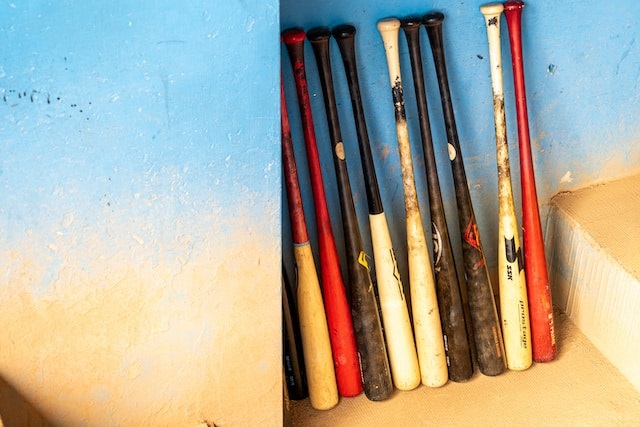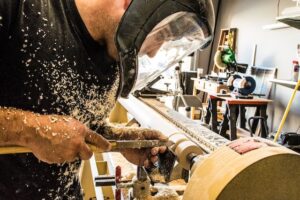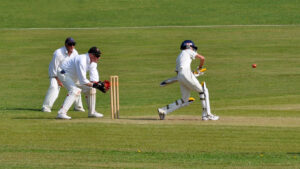The history of baseball bats traces back to the mid-19th century when players began shaping and whittling their bats by hand, resulting in a variety of shapes, sizes, and weights.
From flat bats to round bats and even short and fat bats, the diversity in design was remarkable. Early baseball bats were primarily made from a single piece of wood, often ash or hickory, and were round in shape, measuring up to three feet in length.
As baseball gained popularity in the United States, with clubs forming in New York City and later in Washington, D.C., Massachusetts, Pennsylvania, and Connecticut, regulations surrounding the game and its equipment began to develop.
One notable rule change occurred in the late 1880s, when the National League implemented limits on the use of twine on the handle end of the bat, reflecting the evolution of bat designs and the desire for a more standardized playing experience.
The bat has undergone numerous innovations and changes over the years, with its most famous name emerging in 1884 – when 17-year-old John A. “Bud” Hillerich crafted a bat in his father’s woodworking shop in Louisville, Kentucky, which later became the iconic Louisville Slugger.
Today, baseball bats are a testament to the sport’s rich history and its ongoing evolution, as materials, design, and regulations continue to adapt to the needs and preferences of players and fans alike.
Contents
- History and Evolution of Baseball Bats
- Wood Types and Their Properties
- Baseball Bat Design Elements
- Baseball Bat Regulations
- Significant Moments and Baseball Bats
- Innovative Baseball Bat Technologies
- Unconventional Baseball Bats
- Baseball Bats in Popular Culture
- Relation Between Baseball Bats and Other Sports
History and Evolution of Baseball Bats
Early Days and Innovations
In the mid-19th century, baseball batters shaped or whittled their own bats, resulting in a wide range of shapes, sizes, and weights.
Some examples included flat bats, round bats, short bats, and fat bats. Batters quickly discovered that bats with rounded barrels worked the best.
Early American baseball bats were thick, heavy, and resembled long rolling pins.
Louisville Slugger Era
In 1884, the Louisville Slugger made its debut, forever changing the design and production of baseball bats. Created by 17-year-old John A. “Bud” Hillerich, this bat was made of multiple pieces of wood and featured a curved handle, which was a significant improvement over previous models.
The Louisville Slugger is still one of the most popular baseball bats in use today. Some notable players who used Louisville Sluggers include:
- Babe Ruth
- Lou Gehrig
- Ty Cobb
Material Changes: Wood to Metal
Over time, baseball bat materials evolved from wood to metal. In the 1970s, metal bats made of aluminum became popular in amateur baseball, as they were lighter, stronger, and offered a larger “sweet spot” than wooden bats. However, wooden bats remain the standard in professional baseball due to regulations, tradition, and concerns about aluminum bats potentially making the game too offense-heavy.
Furthermore, various companies, such as Spalding, have introduced innovations in baseball bat materials and designs over the years. Some examples include:
- Bamboo bats: Made from bamboo, these bats are known for their strength, durability, and lightweight design.
- Composite bats: Made of composite materials such as carbon fiber and fiberglass, these bats are lighter and have a larger sweet spot than wooden bats.
Despite the various innovations, wooden baseball bats will always have a special place in the history of the sport. Their design and materials have evolved over the years, but their impact on the game will never be forgotten.
Wood Types and Their Properties
Ash
Ash is a popular wood type used for baseball bats, specifically from the white ash tree. The wood is light, yet strong, and offers an excellent balance of weight and power. Its large, forgiving sweet spot and some flexibility in the handle make it a favorite among hitters. Ash bats, however, have a shorter lifespan compared to other wood types, as the grains tend to separate more easily.
Maple
Maple has become the dominant wood species in MLB. It is a dense, heavy wood, resulting in exceptionally strong bats. Maple bats have a small sweet spot, requiring hitters to be more precise in their swing but also allowing for increased power upon contact. The tight grain structure provides extra durability, making them last longer than ash bats.
Hickory
Hickory was once a popular choice for baseball bats in the early days of the sport. The hickory bat possesses an extremely hard, dense structure which lends itself to power-hitting. However, hickory bats tend to be quite heavy and difficult to control, leading to their decline in popularity as lighter alternatives like ash and maple gained favor.
Bamboo
Bamboo is a non-traditional material sometimes used for baseball bats. Technically a grass, it is processed and laminated, turning it into a highly durable bat. Bamboo offers excellent tensile strength and is known for its resilience, lessening the likelihood of breaking. The stiffness of bamboo bats provides consistency across the hitting surface, but falls short in terms of power compared to traditional solid wood bats like ash and maple.
Pine
Pine is not typically used for baseball bats, as it’s a softwood and lacks the strength and durability needed. Bats made from pine would be prone to breaking and would not deliver the desired performance.
Baseball Bat Design Elements
Handle
The handle is a crucial design element of a baseball bat, as it affects a player’s grip and control while swinging. Traditionally, baseball bat handles were made from ash or hickory wood, which provided a sturdy and reliable grip. Over time, handle designs experimented with various shapes, and today’s bat handles feature a more uniform and slim design for batter comfort and control. Some players also use batting gloves or grip tape to enhance their grip on the handle.
Knob
The knob is located at the end of the bat’s handle and serves as a stopper to prevent the bat from slipping out of a player’s hands during a swing. Early baseball bat knobs were of different shapes and sizes, but modern bat knobs have a more standardized design. Some knobs are rounded, while others have a flatter, square-shaped design. The selection of knob shape is personal preference and depends on a player’s comfort and batting style.
Sweet Spot
The sweet spot of a baseball bat is the area on the barrel where the bat generates the most power and least vibration when it makes contact with the ball.
This region is typically located near the bat’s center of mass, but it can vary slightly depending on the bat’s material and design. The sweet spot is crucial for both power and contact hitters, as connecting with the ball in that area increases the likelihood of solid contact and better ball trajectory.
Over the years, baseball bat materials and designs have evolved, impacting the handle, knob, and sweet spot.
Players can choose from a variety of bat designs to best suit their preferences and enhance their performance on the field.
Baseball Bat Regulations
Regulations in MLB
Major League Baseball (MLB) has specific regulations regarding the size and composition of baseball bats used in the league.
According to the MLB rule book, baseball bats should be no more than 2.75 inches (7.0 cm) in diameter at the thickest part and no longer than 42 inches (1.067 m) in length. These dimensions have been in place since around 1870 and have remained more or less the same since then.
Safety Measures and Standards
To ensure the safety of players and maintain a certain level of performance, baseball governing bodies have put in place strict standards for baseball bats.
These standards apply not only in MLB but also in other leagues, such as college and high school baseball.
Some of the rules and measures include:
- Bats should be made of a smooth wooden or metal material.
- In the late 1800s, the National League limited twine on the handle end of the bat to 18 inches; the rule was later modified to account for rosin and dirt on the handle.
- The bat’s end must be round, a rule that was implemented in the 1890s, and the maximum diameter was increased to 2.75 inches at that time.
Non-certified bats, or those that do not conform to the standards set forth by the governing bodies, are illegal to sell.
Manufacturers and sellers caught selling non-certified bats could face heavy fines and possible jail time as these variations pose a risk to player safety and disrupt the balance of the game.
Significant Moments and Baseball Bats
Babe Ruth’s Record-Breaking Bats
Babe Ruth, one of the most iconic figures in baseball history, had a significant impact on the evolution of baseball bats. In the early days of baseball, players crafted their bats with various shapes and sizes.
Ruth experimented with many different types of bats, eventually settling on a heavy, large-barrel design that he felt improved his hitting prowess.
Throughout his career, Babe Ruth used primarily ash and hickory bats. He favored a bat that was roughly 36 inches long and weighed between 38 to 48 ounces. The use of heavy bats by Ruth influenced other players during the 1920s and 1930s, as many tried to emulate his power and success.
Ruth’s record-breaking bats are highly collectible today, with some examples selling for hundreds of thousands of dollars at auction.
Roger Maris and Home Run Race
Roger Maris, another influential figure in baseball history, also generated significant interest in bat design and performance.
During the 1961 season, Maris and Mickey Mantle engaged in a highly publicized race to break Babe Ruth’s single-season home run record. While Maris ultimately triumphed, hitting 61 home runs, the event sparked a greater focus on bat construction and materials.
During this time, Maris used a Louisville Slugger model, crafted from ash wood. His bat was 35 inches long and typically weighed around 33 ounces. The emphasis on lighter, well-balanced bats during this era helped pave the way for the continued development and standardization of bat designs in the decades to follow.
Innovative Baseball Bat Technologies
Metal Alloy Baseball Bats
The history of baseball bats has seen significant advancements in technology. One of the major innovations was the introduction of metal alloy baseball bats. Metal baseball bats were first introduced in the 1970s and quickly gained popularity due to their lighter weight and increased durability compared to traditional wooden bats. They also offered improved performance, as they could be engineered to have a larger sweet spot and more responsive hitting surface.
- 1970s: Introduction of metal alloy baseball bats
- Advantages: Lighter weight, increased durability, larger sweet spot, more responsive hitting surface
Aluminum Baseball Bats
Aluminum baseball bats emerged as a popular alternative to wooden bats in the late 20th century. These bats utilized technological advancements to become lighter and easier to swing. In the late 1990s, double-walled aluminum bats were introduced, which featured two thin aluminum tubes, a smaller one set inside a larger one. This design further improved the performance and durability of aluminum bats.
- Late 20th century: Emergence of aluminum baseball bats
- Late 1990s: Introduction of double-walled aluminum bats
- Advantages: Lighter, easier to swing, enhanced performance and durability
Axe Bat Evolution
The axe bat is another innovative baseball bat technology that has made an impact on the game. Unveiled in the 2010s, the distinctive feature of the axe bat is its ergonomic knob, slanted at an angle to ensure that the batter’s hand doesn’t rub against it, reducing the risk of injury and the chances of a bat slipping from the player’s grasp. The axe bat design also improves swing efficiency and bat control, enhancing the overall performance of the hitter.
- 2010s: Introduction of axe bat
- Unique feature: Ergonomic, slanted knob
- Advantages: Reduced injury risk, improved swing efficiency, better bat control
These advancements in baseball bat technology have reshaped the game, providing players with more options and improved performance on the field.
Unconventional Baseball Bats
Sawed-Off Bats
Sawed-off bats are a type of unconventional baseball bat that have been shortened from their original length. While most baseball bats conform to standardized lengths and weights, sawed-off bats are customized by players who choose to alter their bats for various reasons. Some may prefer the lighter weight or the unique feel of a sawed-off bat, while others might use it to gain a quicker swing. It’s worth noting that these modifications often do not conform to league regulations and may not be allowed in official play.
42-Inch Length Bats
Another type of unconventional baseball bat is the 42-inch length bat. These bats significantly exceed the standard maximum length of 36 inches (for adult baseball) and provide players with an increased reach. While the additional length might seem advantageous, it also results in a heavier bat that can be more difficult to control.
In the mid-19th century, bats of various shapes and sizes were common, with some reaching up to 42 inches in length. As the sport of baseball evolved and became more regulated, standard bat sizes were established to level the playing field and ensure consistency across leagues.
These unconventional baseball bats have gradually become less popular in modern times due to changes in regulations and the preference for standardized equipment. However, they serve as an interesting glimpse into the evolving history of the baseball bat and its impact on the sport.
Baseball Bats in Popular Culture
National Baseball Hall of Fame
The National Baseball Hall of Fame, located in Cooperstown, New York, honors baseball’s most significant players, managers, umpires, and executives. One of the key items prominently displayed in the Hall of Fame is the baseball bat. Many of the inductees’ bats, showcasing the evolution of the baseball bat and its role in the sport, are meticulously preserved and exhibited for visitors to appreciate.
Movies and Books
Baseball bats have also had their share of spotlight in movies and books. Iconic films like “The Natural” (1984), “Field of Dreams” (1989), and “The Sandlot” (1993) all included baseball bats as pivotal elements in their narratives. In literature, baseball bats have been recurring motifs in novels such as “The Art of Fielding” by Chad Harbach and “Shoeless Joe” by W. P. Kinsella. These works of fiction celebrate and reinforce the significance of the baseball bat as an essential component of the sport’s lore.
Dictionary and Terminology
- Ash: A type of wood commonly used in the construction of baseball bats. Ash is known for its strength and flexibility.
- Hickory: Another type of wood used in creating baseball bats, hickory is heavier and denser than ash, resulting in a more powerful hit but less control.
- Maple: Many modern baseball bats are made from maple, which is a hard, dense wood that provides a combination of strength and durability.
- Cupping: A technique where the end of the bat is hollowed out to reduce weight while maintaining structural integrity.
- Barrel: The part of the bat where the diameter is the largest, typically where players aim to make contact with the ball.
Baseball bats in popular culture highlight the importance of the implement in the history, tradition, and spirit of the sport. From the National Baseball Hall of Fame to movies and books, baseball bats stand as timeless symbols of the game and its enduring appeal among fans and athletes alike.
Relation Between Baseball Bats and Other Sports
Similarities with Cricket Bats
Both baseball and cricket are bat-and-ball games, and their bats share some similarities in design and materials used. Early baseball bats were made from single pieces of wood, typically ash or hickory, which is also true for traditional cricket bats. Today, cricket bats are predominantly made of willow wood, known for its favorable properties in terms of strength and lightness.
While the shapes of baseball and cricket bats are quite different, with baseball bats being round and slender compared to the flat, paddle-like design of cricket bats, both types of bats have evolved to suit the specific needs of their respective sports. In both cases, the bats’ designs allow for optimal contact with the ball and effective transference of energy between the bat and the ball.
Impact of Science on Bat Performance
Over the years, scientific advancements have had a significant impact on the performance of baseball bats. For instance, the transition from traditional ash wood to maple wood in Major League Baseball (MLB) resulted from studies highlighting the advantageous properties of maple, such as its strength and durability.
In addition to experiments with various wood types, other innovations have focused on bat weight distribution and bat handle flexion. By altering these aspects of the bat, scientists and manufacturers have been able to improve power, increase bat speed, and optimize hitting performance for baseball players.
Similarly, cricket bats have undergone technological advancements, with recent models featuring the use of carbon fiber or other composite materials in their construction. The goal is to increase bat strength, reduce weight, and enhance overall performance.
In conclusion, the history of baseball bats and their connection to other sports like cricket highlights the importance of adapting to new advancements in science and technology. As a result, players have access to better-performing equipment, contributing to the continuous evolution of both games.






